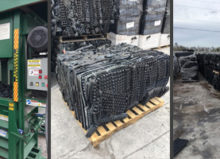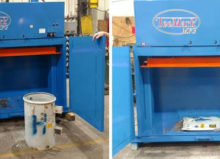What is a Self-Contained Compactor?
 Self-Contained Commercial Waste Compactors are suitable for wet waste. This type of compactor is used if the waste material generates liquid during the compaction process. Compactor and container are integrated and are hauled to landfill with a roll off truck. The power unit is anchored and stays on site. The compactor’s liquid tight containment provides a clean method to handle most any type of trash and is perfect anywhere liquid is part of the waste being disposed.
Self-Contained Commercial Waste Compactors are suitable for wet waste. This type of compactor is used if the waste material generates liquid during the compaction process. Compactor and container are integrated and are hauled to landfill with a roll off truck. The power unit is anchored and stays on site. The compactor’s liquid tight containment provides a clean method to handle most any type of trash and is perfect anywhere liquid is part of the waste being disposed.
Frequently asked Questions
Who would benefit from a Self-Contained Trash Compactor?
Malls, Dairies, Restaurants, Cafeterias, Fast Food, In-Flight Kitchens, Supermarkets, Food Processors, Theme Parks, Resorts, Hospitals, Medical Industries, Institutions, Schools, Universities, Student Housing, Hotels, Distribution Centers, Grocery Stores, Retail Food, Manufacturing Plants, Shopping Plazas, Apartment Bldgs., Casinos, Complexes and Movie Theaters
Benefits of Self-Contained Commercial Recycling Compactors
- Discourages Scavengers
- Saves Labor
- Reduces Collection Costs
- Reduces Insect/Rodent Problems
- Prevents Windblown Trash
- Reduces Fire Hazard
- Controls Odor
- Saves Inside Storage Space and Outside Parking Spaces
- Extends Pavement Life
- Prevents Unauthorized Access to Your Trash
- Prevents Unauthorized Disposal
- Fewer Trips
- Fewer Cleanup Problems – when trash is sealed in a container, there are fewer complaints of messy bin areas
- Reduced Bin Damage/Fires – sealed containers reduce vandalism opportunities
- Liquid Retention – self-contained compactors retain liquids better than any bin, thus eliminating mess associated with liquid refuse
Compaction Ratio
- 4 Trips Loose = 1 Trip Compacted
- 160 cu yds Loose = 40 cu yds Compacted
- 20,000 lbs. Loose (@125 lbs. / cu yd) = 20,000 lbs. Compacted (@500 lbs. /cu yd)
How much does a Self-Contained Recycling Compactor Cost?
They average between $20,000.00 to $25,000.00. Shipping, Installation and Forklift rental are additional costs associated with turn-key sales.
What material can you compact in a Self-Contained Compactor?
Self-contained compactors are designed for wet/liquified waste applications.
They are great for waste with high liquid content, but they are also used for dry waste by those trying to avoid the mess associated with breaking away a stationary compactor’s container. The Self-Contained Recycling Compactor can compact plastic, cardboard, paper, textile, off-date product and defective products.
How much footprint does a Self-Contained Compactor need?
Enough space must exist for the users to bring refuse to the machine, for the machine and container to be adequately serviced and accessed and for the roll off truck to maneuver into position to pick up the container. A minimum of 2 feet must be allowed between the compactor/container and any building or wall to permit accessibility of operators, haulers, and service technicians. A roll off truck must have 24’ of overhead clearance to pick up the container.
Self-Contained Compactor Sizes & Construction
We offer both single cylinder and twin cylinder waste compactor models with 1, 2 and 2.5 cubic yard charge chamber capacities available. A 3/8″ hardened AR plate floor can withstand the abuse of the toughest application and provides the durability and long life you expect from a JV Cram-A-Lot. A full width breaker bar constructed of a single piece of 6″ x 6″ x 3/4″ angle iron will stand up to any trash you can throw at it.
How much does a Self-Contained Compactor weigh?
A self-contained compactor can weigh between 6,500 to 12,000 lbs. depending on the model
How Does a Commercial Self-Contained Compactor Ship?
On a flatbed truck
How do you unload an Industrial Self-Contained Compactor from the truck?
A fork-lift is the most used machine for unloading a vertical baler from the shipping truck. The lifting equipment must be designed for lifting the weight of the compactor.
Installation & Commissioning Considerations for a Self-Contained Compactor
CONCRETE PAD
- Preferred dimensions of the concrete pad are 10 ft. wide and 5’ greater than the length of the compactor/container. It should be level and of minimum 3000 PSI concrete reinforced 6 in. thick. It is preferred that the concrete pad be flush with the surrounding ground level.
- To provide accessibility, the concrete pad should be positioned to allow 2 ft, 4 in between the machine and the building wall if installed parallel with a building. Allow a minimum of 45 ft of clear space from the end of the pad for a container handling vehicle.
Note: The clearances given are minimums. Your installation may require greater clearances depending on the site and the hauling equipment that will be used.
POSITIONING
Position the compactor so that enough room is available for proper and safe operation. The compactor should be placed no less than 28 inches from any structure.
ANCHORING
The compactor guide system should be anchored to the pad with anchor bolts (minimum 3/4” x 5-1/2”). To allow for construction variances, the holes should be drilled after locating the compactor in the desired position.
ELECTRICAL & HYDRAULIC INSTALLATION
A lockable fused disconnect switch (customer furnished) must be installed and be within sight of the compactor motor control panel location, not to exceed 50’ from the compactor. This fused disconnect switch should be sized in accordance with the compactor.
GROUNDING INSTRUCTIONS
This appliance must be connected to a grounded, metal, permanent wiring system or an equipment-grounding conductor must be run with the circuit conductors and connected to the equipment-grounded terminal or lead on the appliance. A qualified electrician should be consulted if there is any doubt as to whether an outlet box is properly grounded.
ELECTRICAL CONNECTIONS
- Run power lines, between fused disconnect switch (customer furnished) and compactor’s motor control panel, in accordance with local electrical codes, using knockouts in bottom of motor control panel.
- Check voltage at fused disconnect to be certain it is the same as is shown on compactor. If voltage is correct, put fused disconnect switch in “ON” position.
- Check motor wiring, voltage and motor rotation.
- Check motor starter, thermal overload selector and voltage.
START-UP INSTRUCTIONS
- With the ram fully retracted, check to be sure the oil reservoir is full on the sight gauge. (Refer to the Maintenance Section for hydraulic oil recommendations). The hydraulic system pressure has been factory set and the entire unit has been operated prior to shipment.
- CAUTION: MAKE SURE PERSONS AND MATERIAL ARE CLEAR OF CHARGE BOX AREA.
- Turn the start key and check the pump for proper rotation. CAUTION: If pump rotates backward, stop immediately. The pump will be damaged if it is operated in reverse even for short periods. Reversing any two incoming power lines will change the motor/pump rotation on three phase power.
- Make sure that the operators are trained in the proper use of this equipment.
How does a Commercial Self-Contained Trash Compactor work?
Standard Operation
- Open chamber door (If not chute fed)
- Fill charge chamber with material to be compacted
- Close chamber door
- Turn the “Start Key Switch”
- Compactor will start and complete one cycle of operation
- The Compactor will continue to operate in this manner until the “Push to Stop” button is pressed or a door is opened. If the Compactor is stopped, it must be restarted with the “Start Key Switch”.
- Repeat steps #1 thru #5 until the container attached to the compactor is full. Contact hauler for dumping.
Electrical Options for the Self-Contained Compactor
- Single Phase Voltage Option (5hp, 230Volts, w/ 2 Stage Pump)
- Three Phase Voltage Options (208 Volts, 230 Volts, 460 Volts, 575 Volts)
Feed Hopper Options for the Self-Contained Compactor
- Thru-The-Wall Door & Sleeve Assembly, e/Magnetic Safety Interlock, 40” Wide
- Break Away Thru-The-Wall Self-Contained Hopper (Includes Mini Hopper)
- Thru-The-Wall Chute, Unassembled, 7’ Long x 40” Wide
- Thru-The-Wall Mini Hopper (No Doghouse)
- Enclosed Hopper, Door on Left w/Magnetic Safety Interlock
- Enclosed Hopper, Door on Right w/Magnetic Safety Interlock
- Enclosed Hopper, w/Door on Left & Right w/Magnetic Safety Interlock
- Enclosed Hopper, Flared to Rear with Barns Doors, w/ Magnetic Safety Interlock
- Open Top Hopper, Flared to Rear
Hydraulic Oil used in the Self-Contained Compactor
- SAE 5W-20 high grade hydraulic oil (Sun 2105 or equivalent)
- Biodegradable Oil
Standard Features Include
- Made in the USA
- Complete UL Listing
- ANSI Z245.2 Compliant
- Cylinders Made in the USA to Our Specification
- Remote Power Unit w/ Weather Cover
- Key Operated Controls
- Quiet Operating Vane Pump
- TEFC Electric Motor
- Spin-On Oil Filter
- 10′ Hydraulic Hoses w/ Quick Disconnect
- Floor Sheet – 3/16″ Single Piece Steel
- Container Rails – 6″ x 2″ Single Piece Structural Tube
- Container Sides – 7-gauge Single Piece Steel
- Tip Top Roof Design Sheds Water
- UHMW Ram Guides assure straight tracking and are readily replaceable
- Heavy Duty Controls – Nema 4 rated pushbutton controls with key-lockable start switch
Preventative Maintenance for the Self-Contained Compactor
We recommend the user of the compactor adopts a program of regularly scheduled maintenance procedures. This schedule should be followed to ensure against premature failure of mechanical or hydraulic components.
INITIAL CHECK
- All nuts and bolts during the first week of use, and then monthly thereafter.
- Hydraulic reservoir should be at the mid to upper range of the sight glass with ram retracted. Use a good quality 5W-20 Hydraulic fluid.
- Hydraulic lines for leaks.
- Hydraulic hose condition. (Check for damage, kinks, etc.).
- Access covers to be sure fasteners are in place.
- Power unit. Remove dust and dirt from outside of control box. Wipe off any dirt or grease, oil, or moisture.
MONTHLY CHECK
- Check external hoses for chafing, rubbing, or other deterioration and damage.
- Check for any obvious unsafe conditions, such as electrical lines or operator obstructions, in compactor area.
- Check oil level in hydraulic reservoir.
- Check functional operation of standard controls and options (stop button, timers, lights, etc.).
- Check hydraulic cylinder and internal hoses for leakages, hoses for chafing and wear.
YEARLY CHECK
- Electrician to check all electrical connections, check motor resistance (recording successive readings helps prevent future failure). Under heavy use, grease the motor. (DO NOT OVER GREASE).
- Hydraulic system—prior to winter season, drain, replace filter and clean inside of reservoir by removing drain plug. Replace plug and refill. Check for tightness. Refill reservoir with high quality 5W-20 Hydraulic fluid.
- Check structure for potential trouble areas and repair as needed.
- Check hoses to ensure that they do not become severely worn before being replaced. A broken hose will allow the reservoir to be pumped dry and ruin the pump.
- Check condition of ram guide shoes. Replace if necessary. Keeping the slide material replaced when necessary will greatly extend the life of the compactor floor and sides.
LUBRICATION
NOTE: Clean-out or maintenance requires the loading chamber cover be open but be sure the compactor ram is extended first. To EXTEND the ram – – first turn the “start” switch and fully extend the ram. When ram is fully extended, press the “STOP” button, and remove the key, lockout/tag-out the power, then the cover can be removed
Available Options for the Self-Contained Garbage Compactor
- Angle Guides with Wheel Stops
- Channel Guides
- Bumper Plate on Dump Door
- Breaker Bar Teeth (Fixed or Hinged)
- 7 Available Understructure / Hook Up Styles
- 75% & 100% Full Lights Combined
- Color Coded Pressure Gauge (Power Unit Mounted or Field Mounted)
- Full Remote Controls, 15’ Lead (Four or Six operators)
- Multi-Cycle Operation, 3 Cycles (with or without selector switch)
- Hold to Run
- Internal Hydraulics Plumbed to Both Sides with Couplers
- Hydraulic & Electric Couplers Located at Dump Door
- Extra Length Power Unit Hose (15, 20, 25, 30ft)
- Oil Heater
- Oil Level Shutdown
- Oil Temperature Shutdown
- Biodegradable Oil
- Sonozaire Odor Neutralizer
- Drain Systems
- Motor Upgrade
- Keypad Access Control
- Bio-Start
- Doghouse, hoppers, chute, etc.
Since 1978, the J.V. Cram-A-Lot brand has been synonymous with reliability and durability. This reputation has been built largely on the outstanding performance of our self-contained compactors. Our legendary SC Series compactors have been designed for maximum reliability and durability. We know that every time the key switch is turned, you need your compactor to start and run trouble free. By integrating simplicity and quality into our machines, we ensure the reliability that you expect and deserve. We optimize our compactor construction for durability by putting the right type of steel and the right amount of steel, in the places that need it most. This attention to robust design ensures that your compactor will be built to last for years to come.
BACE, Corp., LLC manufactures compactors of the highest quality to deliver long life, superior reliability, optimal levels of safety, and the lowest maintenance cost. Beyond the sale, we deliver the most conscientious service in the industry. If you do not know that, it is only because you have not worked with us yet.



